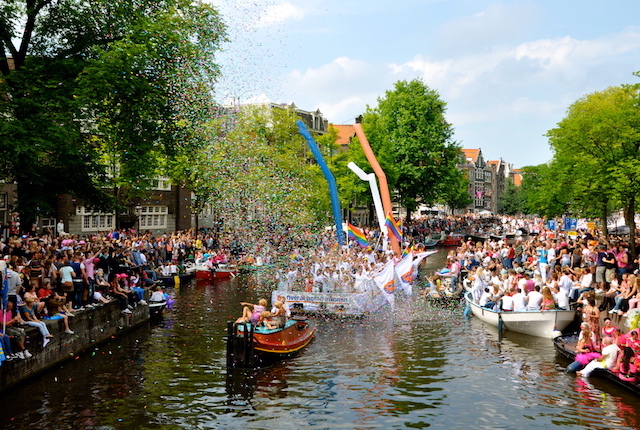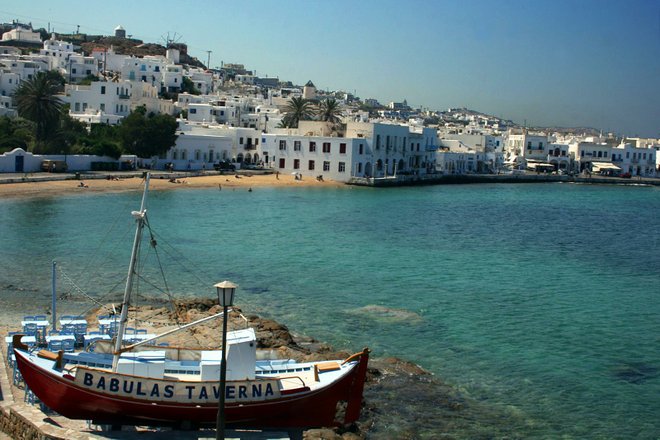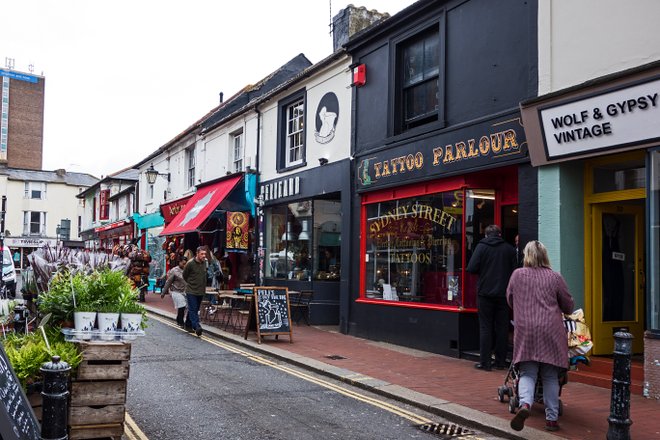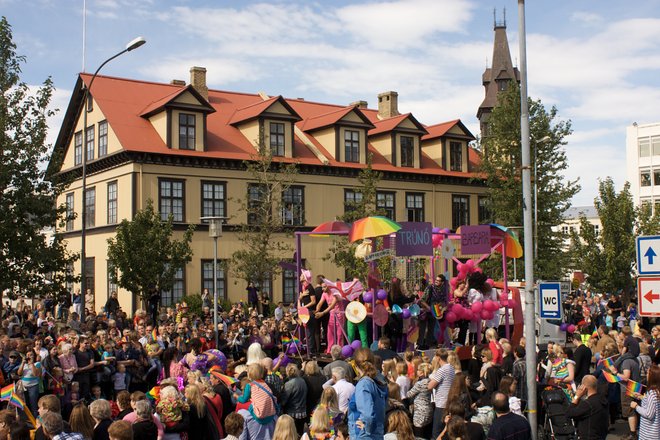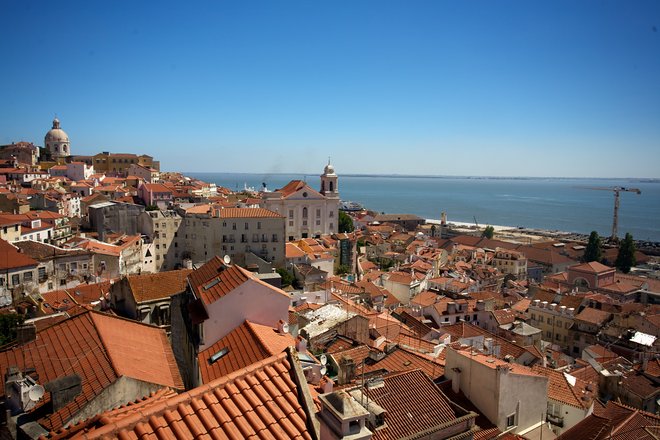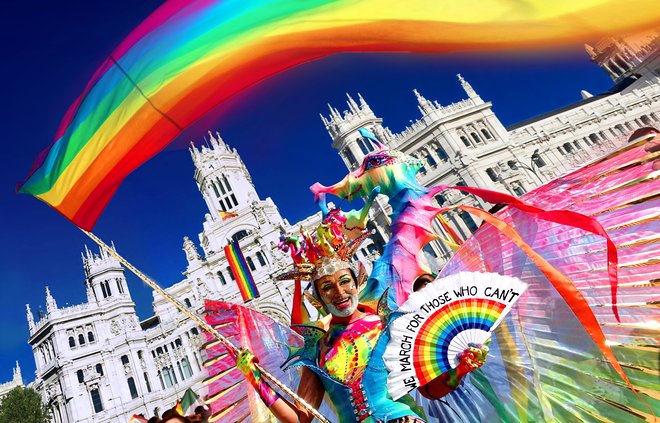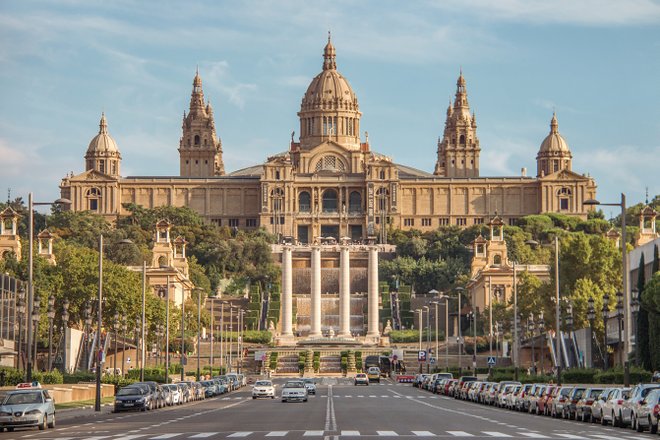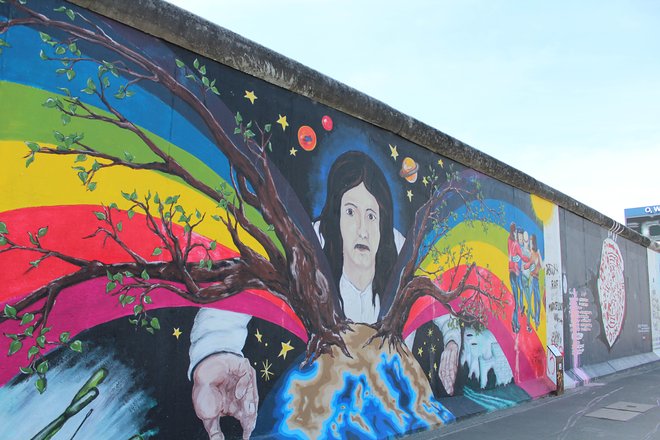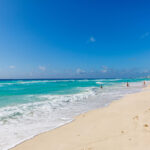June has arrived, meaning that cities around the United States and abroad will start kicking off their Pride festivals, parades, and celebrations. Though much progress has been made in the U.S. and countries around the world, it’s hard to find a more concentrated region of inclusive and welcoming destinations for LGBTQ travelers than Europe. To date, 14 European nations have legalized same-sex marriage, with Switzerland and Austria expected to pass legislation in the coming year. Though the geographical scope of LGBTQ-friendly destinations continues to increase, these eight destinations stand out for their open-mindedness and appeal for LGBTQ travelers.
1. Amsterdam
In 2001, the Netherlands became the first country in the world to legalize same-sex marriage — a whole 14 years before the United States. The main LGBTQ neighborhoods are Kerkstraat, which is home to a host of LGBTQ-oriented hotels, as well as Reguliersdwarsstraat, which is lined with LGBTQ bars near the city center. The gay scene is thriving year-round in Amsterdam, but to see this charming city erupt in full LGBTQ fashion, be sure to time your visit during the coinciding Milkshake and Pride Festivals. This year, Amsterdam Pride is scheduled to run from July 28 to August 5, with Milkshake Festival kicking off the festivities.
Milkshake’s eighth year of operation will see over 50 performers and DJs across several stages in Amsterdam’s outdoor Westerpark. Expect to see plenty of glitter, drag, nudity, and fabulous outfits. After the weekend, the celebrations continue with Amsterdam Pride. The weeklong festival features parades, cabarets, parties, exhibitions, and concerts. One of the most unique features of Amsterdam Pride is the canal parade, in which lavishly adorned boats trace several kilometers throughout the heart of the city. Drag performances, onboard DJs, and even some water jetpacks are all part of the entertainment. Plus, Amsterdam’s 1,281 bridges and narrow canalways allow those on land to get close to the action, too.
2. Mykonos
Part of the Cyclades in the Aegean Sea, Mykonos has become a favorite summer getaway for LGBTQ travelers. The island’s popularity can be traced back to visits from Jackie Onassis and her posse, which led to an influx of chic and trendy hotels and bars. Although its population is largely Orthodox Christian, attitudes have softened considerably over time to create a hospitable atmosphere for a diverse group of visitors.
At just 40 square miles, Mykonos packs in lots to see and do. The main town, Chora, is an architectural beauty with a labyrinth of whitewashed alleyways and houses. Chora’s narrow streets are lined with world-class restaurants, boutiques, galleries, and the island’s liveliest gay bars and clubs (neighboring Jackie O’ and Babylon are popular options). Each one features drag shows, terraces overlooking the Aegean Sea, and partying until dawn. Another excellent option is Elysium, a rooftop bar offering amazing sunset views and the chance to dance alongside go-go dancers into the wee hours of the morning. For a more intimate crowd, head to Montparnasse, a former art gallery that now serves as a gay cabaret bar.
Aside from the nightlife, Mykonos has spectacular beaches catering to all types of travelers. Elia Beach is the go-to spot for the LGBTQ crowd, especially in the summer months. Neighboring Agrari Beach maintains a quieter atmosphere on its rocky coastline, making it popular amongst nudists. Further afield from the big resorts and party scene, Lia Beach and Kalafatis Beach provide a more low-key setting to laze away the day.
Tip: Mykonos becomes significantly more crowded and expensive in the summer, so those looking for a more leisurely trip should consider visiting during the shoulder season. The island can be easily reached via six-hour ferry or domestic flight from Athens.
3. Brighton
Though London may seem like the obvious choice for Britain’s “gay hub,” seaside Brighton has an impressive LGBTQ scene and progressive atmosphere that arguably outshines the British capital. The Kemptown neighborhood — and St. James Street in particular — is the heart of Brighton’s LGBTQ scene. Brighton’s longest-running gay bar, Bulldog, is still going strong, demonstrated by the energetic throngs returning each weekend. Around the corner from St. James Street is Club Revenge, which attracts a diverse LGBTQ crowd and provides excellent views of the English Channel. The Marlborough Pub and Theatre also plays a huge role in the LGBTQ community as the organizer of the annual Brighton Fringe festival, which includes nearly a month of performances before culminating in the Brighton Pride Street Party. Before arriving, be sure to check out Traumfrau for upcoming events, like drag shows, dance parties, and much more.
Brighton Pride is the biggest Pride Festival in the U.K. and lasts for three days each August. The inclusive array of events includes a Carnival of Diversity parade, family activities, and numerous musical performances, with Britney Spears as the headliner. Pride comes a bit late to Brighton (August 3 through 5), compared to the U.S. celebrations in June, so there’s plenty of time to plan a getaway. Additionally, Brighton puts on a Trans Pride festival, which is a segment of the LGBTQ community that is often overlooked in many Pride festivals. The weeklong event runs from July 13 to 20, covering concerts, workshops, and exhibitions.
Beyond the LGBTQ scene, there’s plenty to do in this pleasant seaside city, which can be reached in an hour by train from London, allowing for an easy airport connection or even a day trip. Despite what’s said about gloomy English weather, Brighton’s pier, boardwalk, and pebble beaches are quite active throughout the summer. Brighton also boasts a notable architectural gem — the Royal Pavilion. This massive, minaret-topped seaside palace was commissioned to be a vacation home for King George IV. Luckily, it’s open for public viewing.
4. Iceland
Iceland has been trending for some years now for its otherworldly landscapes, hot springs, and natural beauty. Anyone who has already been to the land of ice and fire will likely agree that openness and creativity permeate Icelandic culture, making it a great destination for LGBTQ travelers. Iceland’s capital, Reykjavik, is the hub for LGBTQ culture and events. Last year’s Pride event in Reykjavik attracted roughly 100,000 people, which is impressive for a country of 334,000 people. This year marks Reykjavik’s 20th Pride festival, which will run from August 7 through 12. Reykjavik also puts on a Pride festival each February — known as Rainbow Reykjavik — which includes Northern Lights excursions, a masquerade party, and more. Another signature event, Bears on Ice, features a diverse array of outdoor activities and themed parties in late summer. Though it caters to the furrier crowed, all are welcome.
If you’re not visiting during one of these festivals, check out Kiki Queer Bar, located on Reykjavik’s main drag — Laugavegur. It’s the only big gay club operating in Reykjavik, and provides a fun atmosphere to dance the night away during runtúr, the unofficial weekend pub crawl. Other venues include Gaukurinn, which hosts drag shows and other LGBTQ events, as well as cozy Bravó. Though Reykjavik hosts the vast majority LGBTQ events and venues, the country as a whole is incredibly welcoming, so there shouldn’t be any concern about traveling through Iceland’s stunning countryside. For example, the small town of Seyðisfjörður, which is nestled among fjords on Iceland’s eastern coast, hosts a Pride parade that receives hundreds of attendees. Seyðisfjörður also recently added a rainbow path following the parade route, which only adds to the charm of the quaint downtown area.
Another cool LGBTQ trivia fact: Iceland was the first country to elect a gay head of state — Johanna Sigurdardottir was elected Prime Minister in 2009.
5. Portugal
Like Iceland, Portugal has been experiencing a well-deserved tourism boom. The relatively small nation delivers superb wine and cuisine, a stunning coastline, historic cities, and an under-the-radar LGBTQ scene. Lisbon, Portugal’s capital, doesn’t always rank among European behemoths like Paris or Rome, but it will delight any visitor with its colorful architecture, beautiful views from the seven hilltops, and dynamic nightlife. To get an authentic Lisbon experience, head to one of the intimate eateries offering live Fado music along the cobblestoned streets of the Alfama or Socorro neighborhoods. The Portuguese have dinner late (around 9 p.m. or later), meaning that the bars in the lively Bairro Alto neighborhood won’t start up until much later either. To mingle with the local LGBTQ community, you’ll want to seek out Rua da Barroca — a narrow cobblestone street that’s chock-full of bars, including several gay bars. Side and Espaço 40e1 are both great for a cocktail before a big night out. Late-night dance spots include Trumps, which has a more mixed crowd, Finalmente, which has fantastic drag shows, and Tr3s Lisboa, which is popular with the boys.
The LGBTQ scene isn’t limited to Lisbon either. Just 18 miles outside of the city, Beach 19 is a favorite LGBTQ getaway and delivers a stretch of quality sand along the Atlantic. Portugal’s mild climate ensures that Beach 19’s beachside bars are open from May through October. Heading south along the coast to the Algarve region, renowned for its magnificent rocky outcrops and sandy shoreline, you’ll find a handful of active LGBTQ venues. These include Connection Club in Albufeira, Prestige in Faro, and The Loft in Portimão.
6. Madrid
When it comes to thriving LGBTQ cities in Europe, Spain’s capital is the tops. This is most apparent in Madrid’s original gayborhood, Chueca, which has served as the LGBTQ community’s gathering point for decades. Unsurprisingly, Chueca still maintains the highest concentration of LGBTQ venues — most notably, Black & White for drag shows and Why Not? for cocktails and dancing. Other trendy spots include La Kama and Gris. Changing attitudes in cosmopolitan Madrid have encouraged the LGBTQ community to permeate to other neighborhoods, like La Latina and Malasańa, as well.
This year will mark the city’s 40th Pride festival, which runs from June 28 through July 8. Though there are plenty of events scheduled throughout the 10-day festival, the biggest celebrations will transpire in the last five days, with five stages set up in plazas across the city. Free music events, parties, and other festivities are all on the calendar. The official Pride parade is set to start on July 7. It runs from 5 p.m. until roughly midnight, but expect the celebrations to continue into the wee hours of the morning. Other not-to-miss experiences include the Drag Race in Heels on July 5 and the Mr. Gay Pride España competition on July 6.
7. Barcelona
LGBTQ travelers will find a dynamic cultural scene and welcoming atmosphere in Barcelona, plus superb nightlife, delicious Catalonian cuisine, and stunning architecture. Gaixample, a section of the L’Eixample district, is known as Barcelona’s gayborhood. Gaixample is home to many of the city’s LGBTQ venues, but friendly establishments can be found all around the city. For a night of pulsing Euro-techno tunes, check out Metro. For a pre-club drink or mellower evening, head to Átame and La Chapelle. Aside from the club and bar scene, the Mediterranean coast beckons with the beaches of Playa de la Mar Bella and Sitges.
Pride Barcelona 2018 strives to combine social issues and celebration through concerts, exhibitions, and other cultural events. This year’s festival seeks to build solidarity and support for LGBTQ refugees in Barcelona by sharing their journeys from countries where being openly gay risks persecution, torture, and even death. The parade is scheduled for June 30 and will navigate the heart of Barcelona, from Jardins de les Tres Xemeneies to Plaza de España. A weekend full of concerts will be staged just off Plaza de España, with many other parties and activities taking place in Gaixample and elsewhere.
8. Berlin
Germany’s capital is home to one of the most dynamic LGBTQ scenes in the world, with everything from gay-friendly clubs, saunas, cafes, and bars. To get a sense of the deep LGBTQ cultural history in Berlin, check out the Schwules Museum, which translates to ‘gay museum. The space features art, literature, and historical exhibitions all pertaining to LGBTQ topics. Historically, the Schöneberg neighborhood has been the de facto LGBTQ hub in Berlin, but over time, other areas like Kreuzberg have joined the ranks of gayborhood status. Nightlife choices cover a broad spectrum of moods and desires, but some recommended spots include Zum Schmutzigen Hobby for a diverse, easygoing atmosphere, the historic Neues Ufer cafe, and Barbie Deinhoff’s to hear local DJs.
Berliners often refer to Pride as Christoper Street Day, in remembrance of the 1969 Stonewall riots in New York City. This year, Christopher Street Day will take place on July 28 and features the motto “My body, my identity, my life.” Though the official parade is July 28, there are scores of parties and events scheduled around the city. Stadtfest, a two-day LGBTQ street festival, precedes Christopher Street Day on July 21 and 22. Last year’s event saw over 450,000 people taking part in drag shows, filling in beer gardens, hitting the dance floors, and enjoying outdoor concerts.
NOW WATCH: 7 Best Honeymoon Destinations for LGBTQ Couples
https://www.youtube.com/watch?v=O1RxeU5Atio
You’ll Also Like:
- 10 Things That Might Happen When You Stay at a Gay Hotel
- The 10 Best Gay-Friendly Neighborhoods in America
- 5 Lesser-Known LGBTQ-Friendly Destinations Around the World
All products are independently selected by our writers and editors. If you buy something through our links, Oyster may earn an affiliate commission.
